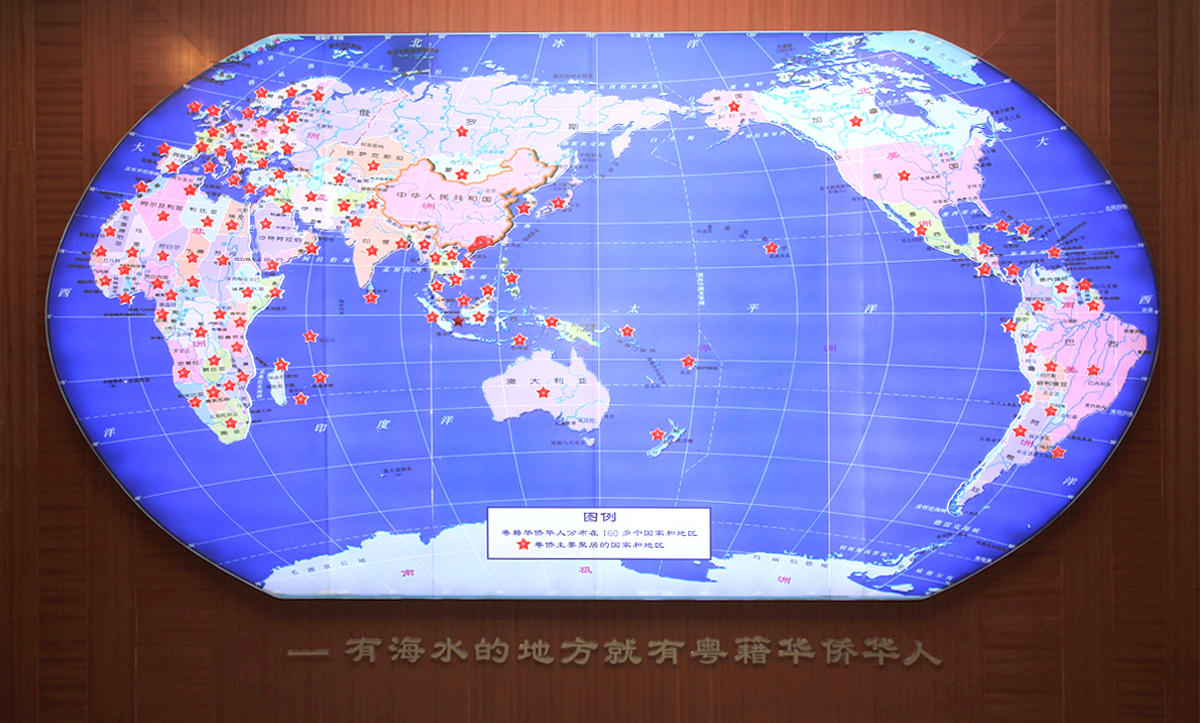2020-09-14来源:本网
【字体:大 中 小】
前 言 广东是全国著名侨乡。有海水的地方就有粤籍华侨华人。自古以来,粤籍先侨,飘扬过海,落地生根,繁荣当地,生生不息。积极支持和参与中国的革命和建设事业,形成了独具特色的广东华侨历史文化。如今,三千多万粤籍华侨华人遍布世界160多个国家和地区,成为中华文化的传播者、中外交往的友好使者、“一带一路”建设的参与者、和平统一的促进者。 建设广东华侨博物馆,旨在铭记华侨历史,缅怀先侨,激励后人,开创未来。《广东华侨历史陈列》主题展由移民海外、艰苦创业、文化传承、浩气长存、情系乡梓、华侨事务六大部分。 Guangdong province is the famous hometown of overseas Chinese. There is an old saying that where we can find the sea, we can find overseas Cantonese. From ancient times to the present, many Cantonese traveled a long way across the sea to settle down in foreign countries, bringing prosperity to both his families and the local people. Nowadays, over 30 million overseas Cantonese live in more than 160 countries and areas, playing the role of Chinese culture disseminator, envoy of friendship between China and other countries, promoter of One Bell One Road , and supporter of peaceful reunification. They have provided great support to China’s revolution and construction. The history and culture of them is of unique characteristic. Why we build this museum is to memorize the history of overseas Chinese and encourage the young people to create a better future. 第一展厅 移民海外 由扬帆世界通商贸易、苦难劳工华侨血泪、排华浪潮艰难岁月、落地生根融入当地四个单元组成,展示广东人移民海外的历史及其原因和特点。广东人移民海外历史悠久,绵延不断。近代以来由于经济、政治、军事、宗教、文化、社会等原因,广东人移民海外,人数多、规模大、分布广,形成了遍布世界的格局。 The first section consists of four parts, foreign trade, indentured labor, Chinese exclusion, and settling down, displaying to audiences the history, reasons, and features of overseas Cantonese’s emigration. Overseas Cantonese has a long emigration history, with the features of great amount, large scale, and wide distribution. 第二展厅 艰苦创业 由垦荒辟地建设城乡、农业、矿业、交通业、商业、工业、金融业、服务业八个单元组成,展示粤籍先侨在海外,面对新环境、新挑战,秉承广东人敢于冒险、开拓务实精神,克服种种艰难险阻,垦荒辟地,掘矿筑路,经商贸易,发展工业和服务业,建设城乡,为住在国的经济社会发展作出贡献,被各国载入史册。 The second section consists of eight parts, virgin land development, agriculture, mining, transportation, commerce, financial industry, and service industry. It displays how the overseas Cantonese overcame new challenges and difficulties abroad. They are audacious and pragmatic to develop virgin land, mines, railways, and service industry, and construct cities and villages, contributing to the economic and social development of countries of residence. They have gone down in the history of many countries. 第三展厅 文化传承 由华人庙宇、华侨社团、华文教育、华文报刊、剧艺、中华武术六个单元组成,展示粤籍先侨在海外聚居生活,建立侨庙、侨团、侨校、侨报,发展侨文化艺术,形成海外华人赖以生存发展的家园—唐人街,成为传播中华文化和中外文化、经贸交流的友好使者。 The third section consists of six parts, Chinese temple, Chinese associations, Chinese education, Chinese media, Chinese drama, and Chinese Kung Fu. It displays the community life of overseas Cantonese abroad, and the development of Chinatown, which is essential to the daily life of overseas Chinese and performs the function of Chinese culture dissemination and business interchange. 第四展厅 浩气长存 由华侨与辛亥革命、航空救国、美国华侨参加飞虎队、华侨与祖国抗日、并肩战斗抗击侵略六个单元组成,展示粤籍华侨身居海外,心系祖国民族兴衰存亡,积极支持、参与孙中山领导的辛亥革命,倾力支持和参加祖国抗日战争,为推翻清朝统治,为祖国抗战胜利作出重大贡献;与侨居国人民共同反对殖民主义和抗击法西斯主义,为世界反法西斯战争的伟大胜利作出重大贡献。 The fourth session consists of six parts, Xinhai revolution, aviation development, Flying Tiger, second sino-Japanese war, and fighting side by side. It displays overseas Cantonese’s deep concern over China’s fate when living abroad. They provided great support to the Xinhai revolution led by Mr. Sun Yat-sen, bravely joined in the second sino-Japanese war, contributed a lot to Chinese people’s victory in wars against feudal governance, Japanese invaders, colonists, and Fascism. 第五展厅 情系乡梓 由实业救国、侨批银信、公益慈善、集体家书、华侨家书、侨乡体育六个单元组成,展示粤籍华侨身居海外,心系祖国家乡,汇款瞻家,买田建屋,修葺祖坟;回国投资发展民族工业,振兴中华;捐资兴办公益事业,促进侨乡经济社会发展,居功至伟。 The fifth section consists of six parts, industry development, remittance letter, charity activities, family letter, and foreign sports. It displays how oversea Cantonese sent money back every month to support his family’s living, buy real estate in China, and renovate family grave. Meanwhile, they made enormous investment and donated much to the charity programs in China, promoting the economic and social development of their hometown. 第六展厅 华侨事务 由晚清侨务、民国侨务、延安侨务、新中国侨务四个单元组成,展示晚清政府设领护侨,派遣幼童留学美国,建立暨南学堂,发展华侨教育,笼络侨商,吸引侨资;国民政府设立侨务机构,废除契约华工制度,辅导归侨学生升学,安置归难侨,吸引侨资,建设城乡,动员华侨抗日;新中国政府健全侨务机构,颁布侨务法规政策,保护华侨归侨正当合法权益;“文革”期间,受极“左”路线影响,侨务工作受到严重冲击,“海外关系”成为反动的社会基础,侨益受损;改革开放后,拨乱反正,全面落实侨务政策,依法护侨,赢得侨心,“海外关系”成为打通各方面的“好东西”。 The sixth session is divided into four parts according to time sequence, the Qing dynasty period, the Republic of China period, the Yanan period, and the People’s Republic of China period. It displays how the Qing government set up consulates abroad to protect overseas Chinese’s rights, send young Chinese to study in the USA, build the Jinan school to develop overseas Chinese education, and attract investment from overseas Chinese. The republic of China set up office of overseas Chinese, abolished indentured Chinese labor system, opened tutoring lesson for returned overseas Chinese students, settled down returned Chinese refugees, and called on overseas Chinese to fight against Japanese invaders. The people’s republic of China improved the operation of overseas Chinese affairs organizations and issued many relevant laws and policies to protect overseas Chinese’s rights. During the cultural revolution period, overseas Chinese affair work was seriously destroyed due to the extremely left-leaning policy. It was after the implementation of the reform and opening up policy that the overseas Chinese affairs work revived and warmed the hearts of overseas Chinese again.





